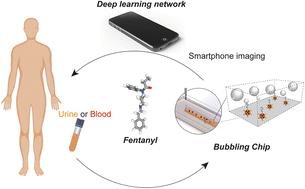Deep learning-assisted sensitive detection of fentanyl using a bubbling-microchip†
Abstract
Deep learning-enabled smartphone-based image processing has significant advantages in the development of point-of-care diagnostics. Conventionally, most deep-learning applications require task specific large scale expertly annotated datasets. Therefore, these algorithms are oftentimes limited only to applications that have large retrospective datasets available for network development. Here, we report the possibility of utilizing adversarial neural networks to overcome this challenge by expanding the utility of non-specific data for the development of deep learning models. As a clinical model, we report the detection of fentanyl, a small molecular weight drug that is a type of opioid, at the point-of-care using a deep-learning empowered smartphone assay. We used the catalytic property of platinum nanoparticles (PtNPs) in a smartphone-enabled microchip bubbling assay to achieve high analytical sensitivity (detecting fentanyl at concentrations as low as 0.23 ng mL−1 in phosphate buffered saline (PBS), 0.43 ng mL−1 in human serum and 0.64 ng mL−1 in artificial human urine). Image-based inferences were made by our adversarial-based SPyDERMAN network that was developed using a limited dataset of 104 smartphone images of microchips with bubble signals from tests performed with known fentanyl concentrations and using our retrospective library of 17 573 non-specific bubbling-microchip images. The accuracy (± standard error of mean) of the developed system in determining the presence of fentanyl, when using a cutoff concentration of 1 ng mL−1, was 93 ± 0% in human serum (n = 100) and 95.3 ± 1.5% in artificial human urine (n = 100).

- This article is part of the themed collection: AI in Microfluidics


 Please wait while we load your content...
Please wait while we load your content...